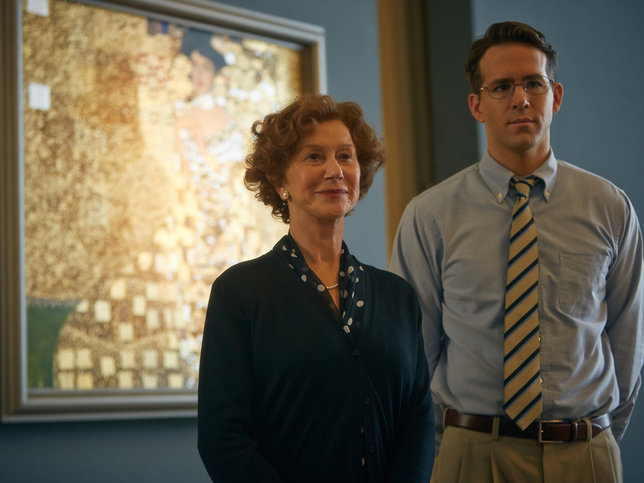Whenever I saw an advertisement or trailer for the Weinstein-approved drama "Woman in Gold," I joked that the movie was "Philomena 2" (or, if I was feeling particularly sassy, "Philomena 2: Geriatric Boogaloo"). After all, the outline is pretty much identical: A young, vaguely cynical whippersnapper teams up with a warm if straight-talking old lady played by a beloved British actress to battle a snooty institution and reclaim a lost part of her heartbreaking past. Find and Replace, say, lost child with lost painting and evil nuns with evil arthouse Austrians, and you’ve just Mad Libs-ed yourself a new movie.
After now seeing the movie in action, however, it turns out that "Woman in Gold" isn’t "Philomena." No, instead it’s what I originally assumed "Philomena" would be (before I saw it and was happily proven wrong): just another blandly respectable, predictable brick of middlebrow crowd-pleasing "based on a true story" weepiness. It may seem a little cynical to toss "Woman in Gold" aside as simply the formula of another successful movie, but considering the textureless and uninvolving results, that’s exactly all that it plays like: a paint by number kit where all of the numbers correspond with shades of beige.
Helen Mirren stars as Maria Altmann, a Jewish L.A. clothing boutique owner hoping to reclaim art pieces stolen from her family during the Nazi occupation of Austria (Tatiana Maslany of "Orphan Black" plays Maria in flashbacks, tearfully fleeing the country while her parents stay back). One of those pieces happens to be Gustav Klimt’s "Woman in Gold," a beautiful gold-leafed portrait of Maria’s aunt Adele now held and displayed as one of Austria’s most prized artistic possessions. And despite the snooty Austrian art restitution board’s constant dismissals and pleadings, she wants it returned to the family.
To do so, she hires on the nebbish Randy Schoenberg (Ryan Reynolds, trying and eventually giving up on being nebbish), a family friend who also happens to be a struggling young lawyer. After enough motherly guilting and nagging, Randy gives in and teams up with Maria to get her family’s priceless history back, despite the fact that he has no experience with art law and a new boss (played by Charles Dance, and you don’t cast Tywin Lannister to feel sympathy) breathing down his neck. Still, with the help of an Austrian journalist (Daniel Bruhl) trying to unveil and undo his country’s sins, the two mount a case against the Austrian government that ends up all the way at the door of the U.S. Supreme Court.
On paper, "Woman in Gold" would seem to have several of the pieces – Courtroom drama! Scrappy underdogs against snobby elitists! Nazis! – making up an engaging story. Under the eye of director Simon Curtis (the also hoitily humdrum "My Week with Marilyn"), however, the movie is aggressively bland. Curtis captures everything predictably nice and clean, but to the point of seeming antiseptic (an odd complaint, but the film has that overly smooth and kind of glazed look digital can sometimes have, which doesn’t help) and devoid of personality.
The movie’s only real creative signs of life come during its flashback sequences. Some suitably rich and warmly luxurious sequences head back to Maria’s wealthy childhood, while other more predominant ones capture the Nazi’s march into Austria – and into Jewish homes – in wannabe grim black and white.
During those latter scenes, Curtis even takes a page from Spielberg, borrowing the now iconic red jacket girl effect from "Schindler’s List" and reincorporating it to make the bright red Nazi banners and armbands violently pop out. It’s an initially interesting technique that, in the end, doesn’t accomplish all that much here. Using it on Nazi paraphernalia is a little misguided and overdone, and anything else red or pigmented similarly (Red Cross signs, browns and even lips) seem to distractingly carry a hue as well. At least it’s an attempt though. Otherwise, for a movie ostensibly about art, there’s not much artistic inspiration to be seen in action.
Its flavorless middlebrow production that only serves to sadly further dull an equally flavorless, middlebrow script. The screenplay from Alexi Kaye Campbell runs through its predictable by-the-books story progression, seemingly rushing to get to its people-pleasing ending.
The two leads are introduced and established as a team very quickly, and any of their tiffs – including two moments where she wants to end the legal battle, easily defeated moments that both clash with her strong, insistent character and more play like tedious plot points than earned emotional ones – end as soon as they seem to start. Another fight between Randy and his concerned wife – played by Katie Holmes, given a non-factor role – is resolved seemingly off-screen a scene later. This is a movie packed with several big speeches and court judgments, but none of them actually register because Campbell and Curtis aren’t building the drama. They’re just wadding together cozy, happy – if blandly felt – triumphs while cliché sniveling Austrian art snobs and jackbooted Nazis twirl their mustaches off to the side.
A movie like "Woman in Gold," however, is too carefully inoffensive to bomb out completely (though, if we’re being honest, that’d probably be more interesting; at least a dumpster fire gets your attention). So you’ve at least got an abnormally deep cast of thespians from across the European Union doing pleasant, respectable work.
Mirren is always a treat, her performance popping whether being sweet and kindly or snappily pesky. Meanwhile while Reynolds – despite his past box office woes – still has leading man charm (and funny smarm) to bring to his role of a lawyer tired of being defined by his past now embracing it, something more annoyingly straight-up told than shown. Bruhl, still yet to cash in on his break-out in "Rush," is a warm presence as well – though his character makes so little impact that when Randy tells him, "We couldn’t have done it without you," the audience might beg to differ. But hey, there’s Jonathan Pryce as Supreme Court Judge William Rehnquist as well! That’s nice!
Also nice: The movie as a whole serves as a deserved tribute to those Jews who had almost all of their prized possessions and so much more stolen by the Nazis and the Austrian people all too willing and happy to abide their rule (a more interesting film might have gone deeper into the country’s conflicted past and present identity). Plus, the coldest, blackest heart couldn’t avoid smiling at a nice, plucky old lady winning out over some snooty art bureaucrats. It’s called a crowd-pleaser for a reason – even if the satisfaction here is hollow and fleeting … and if the old lady then sold the lost portrait of a lost relative for millions upon millions of dollars. Buuuuut whatever.
It’s fitting that the movie opens on a shot of some gold leaf. It’s frustratingly thin and dangerously flimsy, but the Austrian master painter carefully crafts it into an impressive work of art. The gold leaf is "Woman in Gold," and unfortunately no one here is Klimt.
As much as it is a gigantic cliché to say that one has always had a passion for film, Matt Mueller has always had a passion for film. Whether it was bringing in the latest movie reviews for his first grade show-and-tell or writing film reviews for the St. Norbert College Times as a high school student, Matt is way too obsessed with movies for his own good.
When he's not writing about the latest blockbuster or talking much too glowingly about "Piranha 3D," Matt can probably be found watching literally any sport (minus cricket) or working at - get this - a local movie theater. Or watching a movie. Yeah, he's probably watching a movie.







